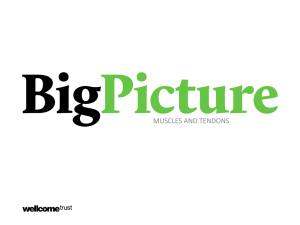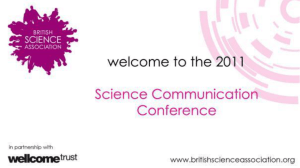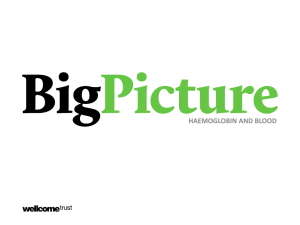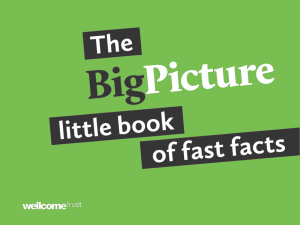History of understanding the brain
advertisement
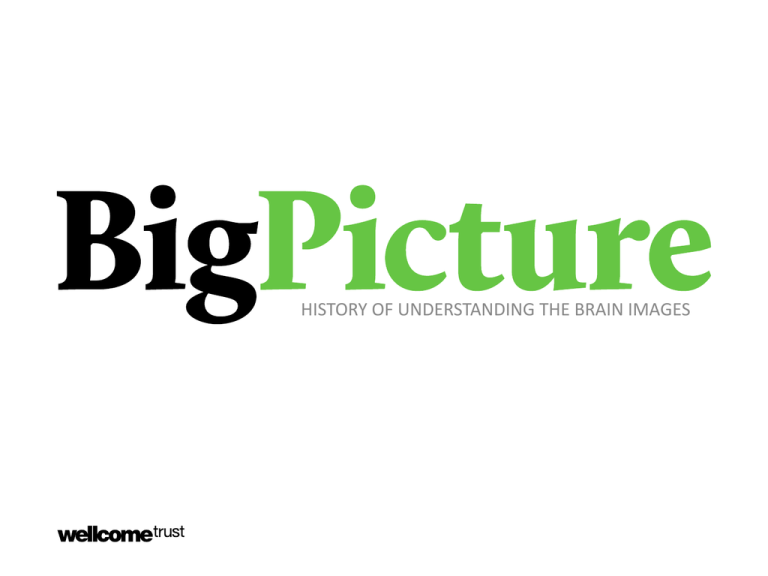
HISTORY OF UNDERSTANDING THE BRAIN IMAGES Trepanned skull This skull shows four separate holes made by a procedure called trepanation. Trepanation is the act of drilling a hole in a human skull and has been practised for thousands of years. The holes had clearly begun to heal, suggesting that although it is highly dangerous, the procedure was by no means fatal. It has been performed to treat a range of medical conditions or as part of a ritual. This skull was excavated from a tomb in Jericho, a Palestinian city near the Jordan River, in 1958. Credit:Science Museum, London/Wellcome Images Illustration of trepanation This is an illustration of a trepanation procedure drawn in 1594 in France. Trepanation is the practice of drilling a hole, or holes, in a human skull. In this picture, one patient is lying still as his skull is trepanned. Another apprehensive-looking man is sitting beside him, preparing to undergo the same operation. The picture was drawn by Jacques Guillemeau, a French surgeon. Credit:Wellcome Library, London BIGPICTUREEDUCATION.COM Trepanation set This set has all the equipment necessary to carry out the trepanation procedure. It is a nine-piece set containing forceps, an elevator (for lifting up bone fragments), a lenticular (an instrument that presses down the brain during surgery), a brush, a rugine (a tool that scrapes the surface of bones to remove any muscles and tendons that are attached) and a trephine (to perform the drilling, with three bits and a handle to undo the drill). The set was manufactured by Guest, a surgical instrument maker based in London during the late 1700s. Credit:Science Museum, London/Wellcome Images BIGPICTUREEDUCATION.COM Phrenology head This image comes from a book by the physician John Elliotson, who practiced phrenology in the early 19th century. Phrenology is the study of the relationship between the shape of the skull and a person’s character. Elliotson describes the picture, which was from 1562, in his book as a very early example of phrenology, before it was a popular scientific theory. Phrenology was discredited in the mid-19th century and stopped being practiced soon after. Credit:Wellcome Library, London BIGPICTUREEDUCATION.COM Skull marked for phrenology Phrenology, the study of the relationship between a person’s character and the shape of their skull, was a popular technique in the early 19th century. This skull has been marked for phrenological demonstration. Some of the markings agree with Franz Joseph Gall’s theories (the founder of phrenology), and some agree with Johann Spurzheim’s (another popular phrenologist in the 1800s). The skull would have been used to demonstrate the different regions of the head and how they link to different character traits of somebody. Credit:Wellcome Library, London BIGPICTUREEDUCATION.COM Painting of a man comparing his head to a skull This painting by Theodore Lane depicts an anxious man comparing his own head to a skull, using the technique of phrenology. Phrenology is the study of the relationship between someone’s character and the shape of their skull. Credit: Wellcome Library, London BIGPICTUREEDUCATION.COM The underneath of the brain This is a drawing of the underneath of the brain from 1664. It comes from ‘Cerebri Anatomae’, a publication by Thomas Willis, a physician who discovered many early parts of the anatomy of the brain. The drawing was by Sir Christopher Wren, a friend of Willis’s and the architect who designed St Paul’s Cathedral in London. The image depicts the circle of Willis, the circle of arteries on the base of the brain, which have been named after Thomas Willis since he discovered them almost 400 years ago. Credit:Wellcome Library, London BIGPICTUREEDUCATION.COM Illustration of a brain tumour This is an image of a brain tumour published between 1829 and 1842 by Jean Cruveilhier. Cruveilhier was a French anatomist and pathologist who produced a work called ‘Anatomie pathologique du corps humain’, which this image comes from. Credit:Wellcome Library, London BIGPICTUREEDUCATION.COM Illustration of the brain This illustration of the brain from a book by Gregor Horst was produced in 1612. At the time the complete anatomy of the brain was still unknown, and this image shows an early depiction of the arteries surrounding the brain. Credit:Wellcome Library, London BIGPICTUREEDUCATION.COM Papier mâché model of the brain The model shows a sectioned human brain made from papier mâché. The parts can be removed to show the internal structure of the brain. This model was used as an aid to teach anatomy; it was made during the first half of the 19th century in France. Credit:Science Museum, London/Wellcome Images BIGPICTUREEDUCATION.COM Early MRI scan of the brain This is an early magnetic resonance imaging (MRI) scan from the 1980s. The first full-body scan was done in 1977, and MRI is now used regularly to assess many different medical conditions. This image shows a normal (healthy) human brain. Credit:Wellcome Images BIGPICTUREEDUCATION.COM Early X-ray of the brain This X-ray image of a section of the base of someone’s brain clearly shows where a bullet is embedded. X-ray was discovered as a medical technique in 1895 by Sir Arthur Schuster, and this image was taken by him in 1896. Credit:Wellcome Library, London BIGPICTUREEDUCATION.COM Anti-neuralgia headband This image is of a galvanic anti-neuralgia headband. Neuralgia is a severe pain caused by irritation or damage to a nerve, where the pain is concentrated along the path of the nerve. This headband was meant to aid headaches caused by neuralgia. The headband is made up of 24 alternating copper and zinc discs, which were tied around the head, with the discs resting on the temples. When the patient’s sweat touched the metal discs, a mild electrical current was produced, called a galvanic current, which was meant to ease the pain. This headband was made in 1879. Credit:Wellcome Library, London BIGPICTUREEDUCATION.COM Skull saw This saw was used to cut open the skull and access the brain. Sir Victor Horsley, an English surgeon and physiologist who pioneered the discipline of neurosurgery in the late 1800s, invented it. It has a nickel-plated handle and a stainless steel blade. The name of the makers, Krohne & Sesemann, is punched onto the blade. It was made between 1900 and 1926 in London. Credit:Science Museum, London/Wellcome Images BIGPICTUREEDUCATION.COM Barbituate ‘Veronal’ is the trade name for a barbiturate drug (a drug that acts as a central nervous system depressant) used to treat mental illness. ‘Veronal’ was the first commercially available barbiturate, sold from 1903 onwards, and was named after the Italian city of Verona. Barbiturates were used to induce sleep by suppressing brain function and were also used as a hypnotic. They were popular up to the 1950s and were an improvement on their predecessors as their side-effects were less severe – although, unfortunately, they could be extremely addictive. Credit:Science Museum, London/Wellcome Images BIGPICTUREEDUCATION.COM Brain sample from a body snatcher Sealed in this small glass specimen jar is said to be a piece of the brain of William Burke (1792–1829). He was one half of the infamous Edinburgh body snatchers known as Burke and Hare. Burke and his accomplice William Hare murdered at least 16 people. They delivered the bodies to anatomy teacher Dr Robert Knox, who paid a high price for them to be used in anatomical classes in Edinburgh. The two body snatchers were eventually caught. Hare testified against Burke and got away with it, leaving Burke to be hanged on 28 January 1829. His body was publicly dissected at the Edinburgh Medical College – the same place he delivered his victims to. Credit:Science Museum, London/Wellcome Images BIGPICTUREEDUCATION.COM Reusing our images Images and illustrations • All images, unless otherwise indicated, are from Wellcome Images. • Contemporary images are free to use for educational purposes (they have a Creative Commons Attribution, Non-commercial, No derivatives licence). Please make sure you credit them as we have done on the site; the format is ‘Creator’s name, Wellcome Images’. • Historical images have a Creative Commons Attribution 4.0 licence: they’re free to use in any way as long as they’re credited to ‘Wellcome Library, London’. • Flickr images that we have used have a Creative Commons Attribution 4.0 licence, meaning we – and you – are free to use in any way as long as the original owner is credited. • Cartoon illustrations are © Glen McBeth. We commission Glen to produce these illustrations for ‘Big Picture’. He is happy for teachers and students to use his illustrations in a classroom setting, but for other uses, permission must be sought. • We source other images from photo libraries such as Science Photo Library, Corbis and iStock and will acknowledge in an image’s credit if this is the case. We do not hold the rights to these images, so if you would like to reproduce them, you will need to contact the photo library directly. • If you’re unsure about whether you can use or republish a piece of content, just get in touch with us at bigpicture@wellcome.ac.uk.


